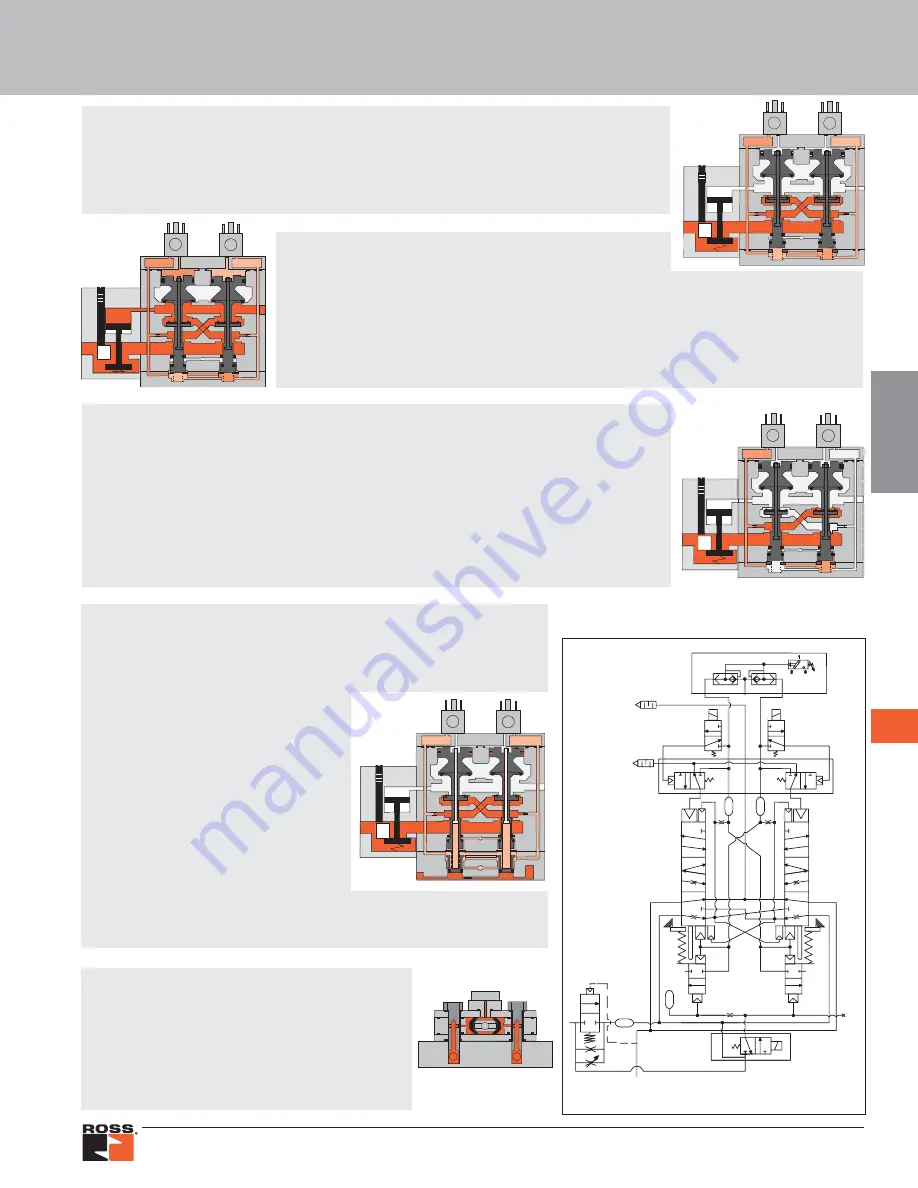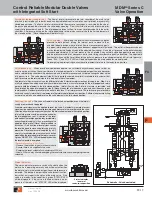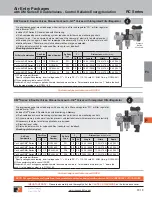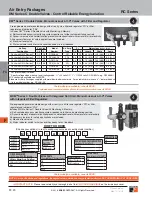
F3.17
www.rosscontrols.com
Online Version
Rev. 11/14/16
Status Indicator:
The status indicator pressure switch will actuate when the
main valve is operating normally, and will de-actuate when
the main valve is in the locked-out position or inlet pressure is
removed. This device is not part of the valve lockout function,
but, rather, only reports the status of the main valve. If the
valve is in a ready-to-run condition, a green “STATUS” LED
will be displayed. If the valve is faulted or there is no air
pressure at the inlet, a red “STATUS” LED will be displayed.
Resetting the valve:
The valve will remain in the locked-out position, even if the inlet air
supply is removed and re-applied.
A remote reset signal must be applied to reset the valve. A momentary, remote electrical
signal must be applied to the reset solenoid to apply pressure to the reset pistons in the valve.
Actuation of the reset piston physically pushes the main valve elements to their closed position.
Inlet air fully pressurizes the crossovers and holds
the inlet poppets on seat. Actuation of the reset
piston opens the reset poppet, thereby, immediately
exhausting pilot supply air, thus, preventing valve
operation during reset (Reset adapter added to
illustration.). De-actuation of reset pistons causes
the reset poppets to close and pilot supply to fully
pressurize. Reset air pressure is applied by a 3/2
normally closed solenoid, or a manual push button
mounted on the reset adapter in the top valve cover.
A green “RESET SOL.” LED will be displayed when
the reset solenoid is energized.
The reset procedure is as follows:
•
Remove the electrical signals to the main coils
•
Ensure there is air supplied to the valve
•
Energize the reset solenoid for a minimum of 200 ms
•
Allow a 200 ms delay after de-energizing the reset solenoid and re-energizing the main
solenoids
Valve locked-out:
Whenever the valve elements operate in a sufficiently asynchronous manner, either on
actuation or de-actuation, the valve will move to a locked-out position. In the locked-out position, one crossover
and its related timing chamber will be exhausted, and the other crossover and its related timing chamber will be
fully pressurized. The valve element (side B) that is partially actuated has pilot air available to fully actuate it, but
no air pressure on the return piston to fully de-actuate the valve element.
Air pressure in the crossover acts on the differential of side B stem diameters creating a latching force. Side A is in
a fully closed position, and has no pilot air available to actuate, but has full pressure on the inlet poppet and return
piston to hold the element in the fully closed position. Inlet air flow on side A into its crossover is restricted, and
flows through the open inlet poppet on side B, through the outlet into the exhaust port, and from the exhaust port
to atmosphere. Residual pressure in the outlet is less than 1% of inlet pressure. The return springs are limited in
travel, and can only return the valve elements to the intermediate (locked-out) position. Sufficient air pressure acting
on the return pistons is needed to return the valve elements to a fully closed position.
Valve actuated:
Energizing the pilot valves simultaneously applies
pressure to both pistons, forcing the internal parts to move to their
actuated (open) position, where inlet air flow to crossover passages is
fully open, inlet poppets are fully open and exhaust poppets are fully closed. The outlet is then pressurized at
a rate allowed by the fixed orifice and the adjusted flow control. Once the air pressure in the outlet chamber
reaches approximately 60% of inlet pressure, the air piloted 2-way normally closed poppet valve opens fully
and the pressure in the inlet, crossovers, outlet, and timing chambers are quickly equalized. The adjustable
flow control will control the time it takes for the outlet air pressure to reach approximately 60% of inlet pressure.
Green “SOL. 1” and SOL. 2” LEDs will be displayed when the main solenoids are energized.
De-energizing the pilots quickly causes the valve elements to return to the ready-to-run position.
EXHAUST
T
T
T
T
T
T
INLET
OUTLET
EXHAUST
OUTLET
INLET
A
B
ADJUSTING NEEDLE
EXHAUST
T
T
T
T
T
T
T
INLET
OUTLET
EXHAUST
OUTLET
INLET
A
B
ADJUSTING NEEDLE
EXHAUST
OUTLET
INLET
A
B
ADJUSTING NEEDLE
Status indicator
in normal
ready-to-run position
Valve de-actuated (ready-to-run):
The flow of inlet air pressure to the inlet chamber of the main valve
internals is restricted by a fixed orifice and an adjustable flow control as well as an air piloted 2-way normally
closed poppet valve. The flow of inlet air pressure into the crossover passages is restricted by the size of
the passage between the stem and the valve body opening. Flow is sufficient to quickly pressurize pilot
supply/timing chambers A and B. The inlet poppets prevent air flow from crossover passages into the outlet
chamber. Air pressure acting on the inlet poppets and return pistons securely hold the valve elements in
the closed position. (Reset adapter omitted for clarity.)
Reset
port
Pressure
Switch
Exh.
Exh.
Exh.
2
1
3
EXHAUS
S
T
T
T
T
T
T
INLET
OUTLET
EXHAUST
OUTLET
INLET
A
B
ADJUSTING NEEDLE
Schematic - Valve de-actuated
Control Reliable Modular Double Valves
with Integrated Soft Start
M DM
2®
Series C
Valve Operation
F
F3

























